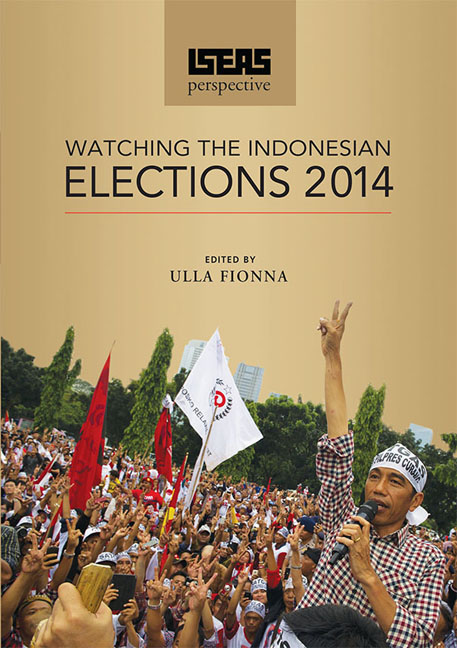Book contents
- Frontmatter
- Contents
- Foreword
- Introduction
- 1 The Gubernatorial Race in Jakarta: Background and Implications
- 2 Indonesian Parties Struggle for Electability
- 3 Who Will Be Indonesian President in 2014?
- 4 Indonesian Presidential Election Forcing Rejuvenation of Parties
- 5 Resisting Democracy: Front Pembela Islam and Indonesia's 2014 Elections
- 6 Getting to Know the Contestants of the 2014 Indonesian Parliamentary Elections
- 7 A Snapshot of the Campaigning in Indonesia's 2014 Legislative Elections
- 8 Unpacking the Results of the 2014 Indonesian Legislative Elections
- 9 Indonesia's 2014 Legislative Elections: The Dilemmas of “Elektabilitas” Politics
- 10 The Islamic Factor in the 2014 Indonesian Elections
- 11 Vote-buying in Indonesia's 2014 Elections: The Other Side of the Coin
- 12 Gap Narrows Between Candidates in Indonesian Presidential Elections
- 13 Analysing the Economic Platforms in the Indonesian Presidential Election
- 14 Indonesian Islamic Parties After the 2014 Elections: Divided and Self-Centred
- 15 Safeguarding Indonesia's Pluralism: An Essential Task for Joko Widodo
- 16 Jokowi's Key Economic Challenge: Improving Fiscal Policy for Equitable Growth
- 17 Crossing the River While Avoiding the Stones: Jokowi's Run-up to the Presidency
- 18 Post-elections Indonesia: Towards a Crisis of Government?
- Epilogue: Jokowi's First Months: Compromise Cabinet, Subsidy Cuts, and Corrupt Coalition
9 - Indonesia's 2014 Legislative Elections: The Dilemmas of “Elektabilitas” Politics
Published online by Cambridge University Press: 29 July 2017
- Frontmatter
- Contents
- Foreword
- Introduction
- 1 The Gubernatorial Race in Jakarta: Background and Implications
- 2 Indonesian Parties Struggle for Electability
- 3 Who Will Be Indonesian President in 2014?
- 4 Indonesian Presidential Election Forcing Rejuvenation of Parties
- 5 Resisting Democracy: Front Pembela Islam and Indonesia's 2014 Elections
- 6 Getting to Know the Contestants of the 2014 Indonesian Parliamentary Elections
- 7 A Snapshot of the Campaigning in Indonesia's 2014 Legislative Elections
- 8 Unpacking the Results of the 2014 Indonesian Legislative Elections
- 9 Indonesia's 2014 Legislative Elections: The Dilemmas of “Elektabilitas” Politics
- 10 The Islamic Factor in the 2014 Indonesian Elections
- 11 Vote-buying in Indonesia's 2014 Elections: The Other Side of the Coin
- 12 Gap Narrows Between Candidates in Indonesian Presidential Elections
- 13 Analysing the Economic Platforms in the Indonesian Presidential Election
- 14 Indonesian Islamic Parties After the 2014 Elections: Divided and Self-Centred
- 15 Safeguarding Indonesia's Pluralism: An Essential Task for Joko Widodo
- 16 Jokowi's Key Economic Challenge: Improving Fiscal Policy for Equitable Growth
- 17 Crossing the River While Avoiding the Stones: Jokowi's Run-up to the Presidency
- 18 Post-elections Indonesia: Towards a Crisis of Government?
- Epilogue: Jokowi's First Months: Compromise Cabinet, Subsidy Cuts, and Corrupt Coalition
Summary
INTRODUCTION
On 9 April 2014, around 200,000 people stood for election to 20,257 seats in the Regional and Provincial Legislative Councils (DPRD), the House of Representatives (DPR) and the Regional Representatives Council (DPD). Of these, 6,607 candidates from twelve parties competed for the 560 seats in the DPR, while the remainder ran for the 132 seats in the DPD, the 2,137 provincial seats and the 17,560 regional seats. There are 1,344 new seats, mostly in the regional parliaments and 123 in provincial parliaments.
One week after the elections, more and more reports have surfaced of cheating during vote counting. Most of the reports are about switching counting of ballot papers for one candidate to another for money. This is possible with the bribery of election officials. Initially, complaints came from candidates who had been unable to mobilize enough supporters to be scrutinizers at the very large number of voting centres in each constituency. Their ballot papers were especially vulnerable. If those who lost votes due to cheating can document this, there may be a round of court cases disputing votes in different constituencies. It is difficult to know the extent of cheating at this time, but it is unlikely to change the overall picture presented by the election results.
WHAT HAVE THE ELECTIONS REVEALED?
Overall, the elections have confirmed the alienation between the mass of the population and the existing parties.
GOLPUT the Winner
Most election analysts are confirming a formal absentee voter rate (GOLPUT) at 34 per cent, up from 29 per cent in the 2009 elections. This only includes the percentage of registered voters who did not vote. It does not include people who are eligible to register to vote but did not. Nor does it include spoilt votes. It is probable that the real absentee vote is at least 40 per cent, i.e., at most only 60 per cent of the population voted.
There was a massive television advertising campaign, backed also by the party leaders, urging people not to “GOLPUT”. On Election Day, television hosts as well as politicians were still confident that there would be a drop in GOLPUT.
- Type
- Chapter
- Information
- ISEAS PerspectiveWatching the Indonesian Elections 2014, pp. 75 - 84Publisher: ISEAS–Yusof Ishak InstitutePrint publication year: 2015



